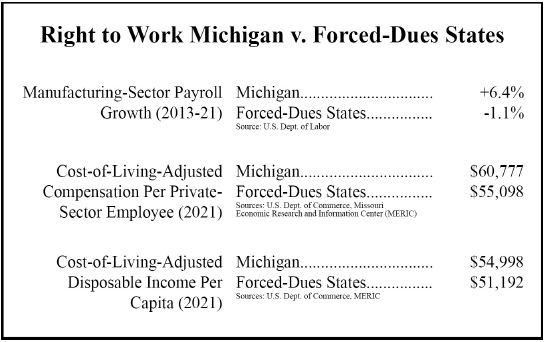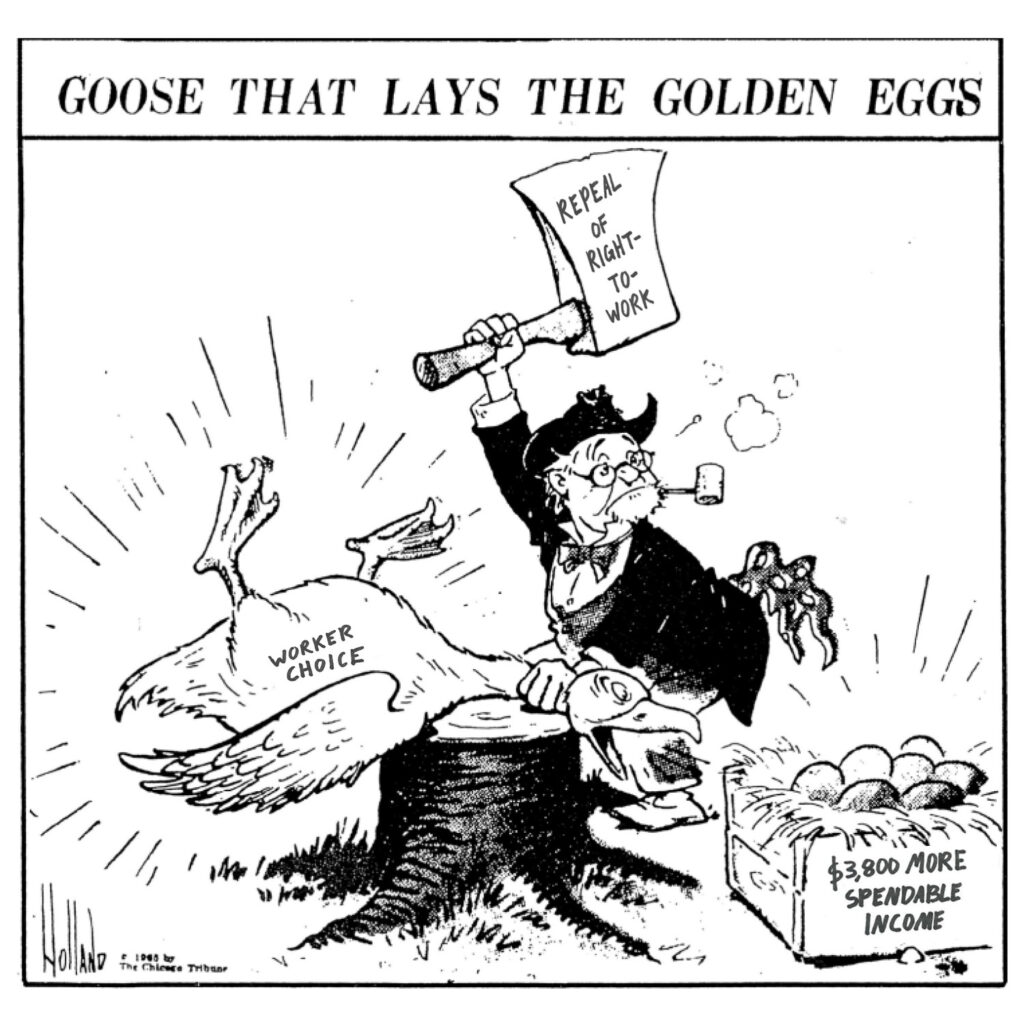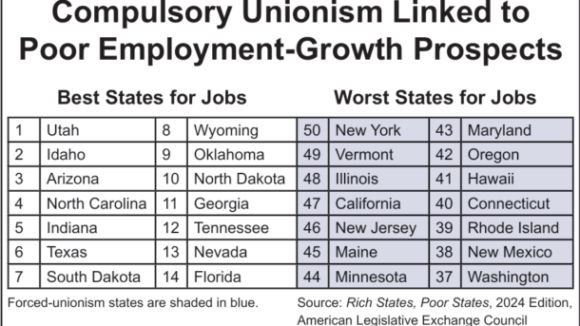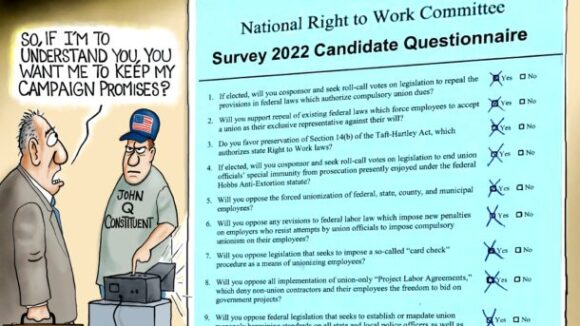Is This Any Way to Run a City’s Schools?
Leaked CTU Proposals Won’t Do Anything to Improve Schools’ Poor Performance

Despite their manifest dominance over Democrat politicians who hold the governorship and majority control in both chambers of the General Assembly in Michigan this year, Big Labor bosses’ ongoing campaign to repeal the Wolverine State’s decade-old Right to Work law faces a few major obstacles.
One is the burgeoning grassroots coalition of independent-minded employees, small business owners, taxpayers, and other freedom-loving citizens who are fighting intensely to save Right to Work protections in Michigan.
This movement is benefiting from the knowledge and experience of National Right to Work Committee leaders, who have been visiting the state regularly since the repeal battle began shortly after the 2022 elections, and of Committee field staff who are on the ground in the state for the duration of the fight.
Another key obstacle for Right to Work foes is plain old math.
Current and historical data furnished by the U.S. Labor Department, the U.S. Commerce Department, and other federal agencies, as well as state government agencies and nonpartisan private researchers, simply won’t follow the economic narrative forced-unionism apologists are trying to advance.
Committee Vice President John Kalb commented:
“The fact is, hard numbers show Michigan was doing a miserable job at attracting and retaining well-paid jobs for years and years prior to 2013, when its Right to Work law took effect.
“And the same data show the state has become a much better place for employees and their families, as well as for business owners, with Right to Work on the books.
“For example, from 2002 to 2012, manufacturing employment in forced-unionism Michigan fell by 29.6%.
“This was a time when manufacturing employment nationwide was shrinking, but Michigan’s percentage loss was greater by more than a third than the national average.”
Mr. Kalb continued:
“Over the first five years of Right to Work, Michigan enjoyed its strongest manufacturing rebound in decades, with factory employment rising by 80,000.”
Since Big Labor Democrat Gov. Gretchen Whitmer took office in early 2019, the state has done less well, largely because of her administration’s refusal to use Right to Work as a selling point to businesses across the U.S. and around the world.
Nevertheless, from 2013 through 2021, the last year for which state annual data are available as this Newsletter edition goes to press, manufacturing jobs in Michigan grew by 6.4%, more than twice as rapidly as they did nationwide.
Over those same eight years, manufacturing employment in the 23 states that still lack Right to Work laws today actually fell by 1.1%.
Mr. Kalb pointed out that Michigan has also fared much better with its Right to Work law than before according to several key income measures.
For example, from 2005 to 2012, forced-unionism Michigan’s median household income as reported by the U.S. Census Bureau fell by 13.5%, after adjusting for inflation according to the consumer price index.
In sharp contrast, from 2013 through 2021, the median, inflation-adjusted household income in Michigan rose by 12.9%.
Of course, when the public debate over a Michigan Right to Work law was heating up as businesses struggled to recover from the Great Recession of 2008-9, Big Labor propagandists dismissed the very possibility that banning forced union dues and fees as a job condition would bring economic benefits to the state.
In fact, in a 2011 “briefing paper,” Gordon Lafer of the Big Labor-founded Economic Policy Institute (EPI) went so far as to suggest that Right to Work passage would lead to even greater declines in the state’s real median household income, rather than the positive turnaround that actually occurred.
Today, Big Labor bosses and politicians in Michigan continue to cite the EPI’s propaganda as authoritative, even though Dr. Lafer and other EPI representatives turned out to be completely wrong about what would happen if the state went Right to Work.
“Apparently,” said Mr. Kalb, “union bigwigs like state AFL-CIO chief Ron Bieber think that if they don’t acknowledge real household incomes have gone up substantially since Michigan’s Right to Work law took effect, no one else will notice that’s the case!”

Right to Work Michigan’s already solid record of income growth is even more impressive when the anti-inflationary impact of prohibiting compulsory union dues as a job condition, which has been well documented by economists such as Thomas Carroll and Richard Cebula, is factored in.
Undoubtedly thanks in part to Right to Work protections, the overall cost of living in Michigan relative to the 23 remaining forced-dues states fell by roughly 9% between 2012, the last year before those protections were instituted, and 2021.
This estimate is based on annual state cost-of-living indicies calculated by the Missouri Economic Research and Information Center (MERIC), a state government agency.
In 2012, the average after-tax income per capita in forced-unionism Michigan, adjusted for regional differences in the cost of living using MERIC’s indices for that year, was $43,748 (in 2021 dollars).
That was $160 lower than the average for the 23 states that are still non-Right to Work today.

By 2021, the average after-tax income per capita in Michigan, adjusted for regional differences in the cost of living using MERIC’s annual indices for that year, had soared to $54,998.
That was 7.4%, or $3,806, higher than the forced-unionism average.
Mr. Kalb commented:
“Widespread public awareness of how Right to Work has facilitated the creation and retention of good jobs and helped real, spendable incomes grow more rapidly in Michigan than in forced-dues states is undoubtedly part of the reason why popular support for keeping union membership voluntary is so strong.
“For example, according to a statewide scientific poll conducted late last year by SurveyUSA, an overwhelming 88% of Michigan voters agree with this statement:
‘Workers should never be forced, or coerced, to join a union or pay dues to a union.’
“This poll ought to be a flashing red light for Democrat Gov. Gretchen Whitmer and Democrat legislative leaders who are being egged on by union bosses, including the ethically-challenged hierarchy of the corruption-ridden United Auto Workers union, to destroy Michigan’s Right to Work law.
“The vast majority of Michigan citizens clearly don’t want politicians to eliminate a policy that is serving employees, businesses, and the public as a whole well.
“Any Michigan politician who ignores the economic facts and the polls and goes after Right to Work in 2023 will do so at his or her own peril.
“Fortunately, perhaps because they know that what Big Labor is asking them to do is unpopular, and that Right to Work forces are already prepared to hold them accountable for their actions, Ms. Whitmer and her allies in the Michigan General Assembly may well put off a showdown on Right to Work repeal for weeks or months.
“But regardless of when this showdown happens, the Committee and its Michigan partners will be ready.”
This article was originally published in our monthly newsletter. Go here to access previous newsletter posts.
To support our cause and help end forced unionism, go here to donate.

Leaked CTU Proposals Won’t Do Anything to Improve Schools’ Poor Performance

Wherever Big Labor wields the power to collect forced union dues, union bosses funnel a large share of the confiscated money into efforts to elect and reelect business-bashing politicians. Employment growth tends to lag as a consequence.

Members Insist They Keep Pro-Right to Work Campaign Promises